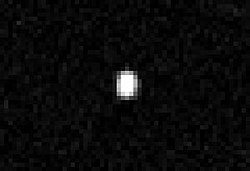50000 Quaoar
asteroid
50000 Quaoar adalah objek trans-Neptunus biner dan kandidat planet kerdil yang mengorbit Matahari di sabuk Kuiper. Ia ditemukan pada tanggal 4 Juni 2002 oleh astronom Chad Trujillo dan Michael Brown di California Institute of Technology, dari gambar diperoleh Teleskop Oschin Samuel di Observatorium Palomar.
 Gambar Quaoar yang diambil dari Teleskop Luar Angkasa Hubble pada tahun 2002 | |
| Penemuan [1] | |
|---|---|
| Ditemukan oleh | C. Trujillo M. E. Brown |
| Situs penemuan | Palomar Obs. |
| Tanggal penemuan | 6 Juni 2002 |
| Penamaan | |
| (50000) Quaoar | |
| Pelafalan | /ˈkwɑːwɑːr/[a] |
Asal nama | Quaoar [2] (deity of the Tongva people) |
| 2002 LM60 | |
| Objek Trans-Neptunus [3] | |
| Ciri-ciri orbit [3] | |
| Epos 27 April 2019 (Hari Julian 2458600.5) | |
| Parameter ketidakpastian 3 | |
| Rentang pengamatan | 64.044 hari (23,376 hari) |
Tanggal precovery terawal | 25 Mei 1954 |
| Aphelion | 43.6916 AU |
| Perihelion | 41.9635 AU |
| 43.6916 AU | |
| Eksentrisitas | 0.0396 |
| 288.81 tahun (105,416 h) | |
| 300.7086° | |
| 0° 0m 12.287s / hari | |
| Inklinasi | 7.9881° |
| 188.8372° | |
| 146.4064° | |
| satelit yang diketahui | 1 (Weywot; D: 81±11 km)[4] |
| Ciri-ciri fisik | |
Diameter rata-rata | 1110±5 km [5] 1074±38 km[6] |
Jari-jari rata-rata | 555±2,5 km [5] |
| Kepepatan | 0,0897±0,006[5] |
| Massa | (1,4±0,1)×1021 kg[6][7] 0.12 Massa Eris [8] |
Massa jenis rata-rata | 1,99±0,46 g/cm3[5] 2,18+0,43 −0,36 g/cm3[6] |
Gravitasi permukaaan ekuator | ≈ 0.3 m/s2 |
Kecepatan lepas ekuator | ≈ 1.83 m/s |
| 17,6788 j[9] | |
| 0,109±0,007[5] | |
| (cukup merah) B–V =0,94±0,01[10] V−R = 0,64±0,01[10] | |
| 19.3[11] | |
| 2,82±0,06[5] 2.4[3] | |
Catatan sunting
- ^ Brown's website[12] gives a three-syllable pronunciation, /ˈkwɑːoʊwɑːr/, as an approximation of the Tongva pronunciation Templat:IPA-azc. However, his students pronounce it with two syllables, /ˈkwɑːwɑːr/, reflecting the usual English spelling and pronunciation of the deity, Kwawar.[13]
Referensi sunting
- ^ "50000 Quaoar (2002 LM60)". Minor Planet Center. Diakses tanggal 30 November 2017.
- ^ Schmadel, Lutz D. (2007). "(50000) Quaoar". Dictionary of Minor Planet Names – (50000) Quaoar. Springer Berlin Heidelberg. hlm. 895. doi:10.1007/978-3-540-29925-7_10041. ISBN 978-3-540-00238-3.
- ^ a b c "JPL Small-Body Database Browser: 50000 Quaoar (2002 LM60)" (2018-05-25 last obs.). Jet Propulsion Laboratory. Diakses tanggal 27 February 2018.
- ^ Green, Daniel W. E. (22 February 2007). "Satellites of 2003 AZ_84, (50000), (55637), and (90482)". International Astronomical Union Circular. Central Bureau for Astronomical Telegrams. hlm. 1. Bibcode:2007IAUC.8812....1B. Diarsipkan dari versi asli tanggal 19 July 2011.
- ^ a b c d e f Braga-Ribas, F.; Sicardy, B.; Ortiz, J. L.; Lellouch, E.; Tancredi, G.; Lecacheux, J.; et al. (August 2013). "The Size, Shape, Albedo, Density, and Atmospheric Limit of Transneptunian Object (50000) Quaoar from Multi-chord Stellar Occultations". The Astrophysical Journal. 773 (1): 13. Bibcode:2013ApJ...773...26B. doi:10.1088/0004-637X/773/1/26. Diakses tanggal 27 February 2018.
- ^ a b c Fornasier, S.; Lellouch, E.; Müller, T.; Santos-Sanz, P.; Panuzzo, P.; Kiss, C.; et al. (July 2013). "TNOs are Cool: A survey of the trans-Neptunian region. VIII. Combined Herschel PACS and SPIRE observations of nine bright targets at 70-500 µm". Astronomy and Astrophysics. 555: 22. arXiv:1305.0449v2 . Bibcode:2013A&A...555A..15F. doi:10.1051/0004-6361/201321329. Diakses tanggal 27 February 2018.
- ^ Fraser, Wesley C.; Batygin, Konstantin; Brown, Michael E.; Bouchez, Antonin (January 2013). "The mass, orbit, and tidal evolution of the Quaoar-Weywot system". Icarus. 222 (1): 357–363. arXiv:1211.1016 . Bibcode:2013Icar..222..357F. doi:10.1016/j.icarus.2012.11.004.
- ^ Fraser, Wesley C.; Brown, Michael E. (May 2010). "Quaoar: A Rock in the Kuiper Belt". The Astrophysical Journal. 714 (2): 1547–1550. arXiv:1003.5911 . Bibcode:2010ApJ...714.1547F. doi:10.1088/0004-637X/714/2/1547.
- ^ "LCDB Data for (50000) Quaoar". Asteroid Lightcurve Database (LCDB). Diarsipkan dari versi asli tanggal 2019-01-11. Diakses tanggal 30 November 2017.
- ^ a b Tegler, Stephen C. (1 February 2007). "Kuiper Belt Object Magnitudes and Surface Colors". Diarsipkan dari versi asli tanggal 2006-09-01. Diakses tanggal 27 February 2018.
- ^ "AstDys (50000) Quaoar Ephemerides". Department of Mathematics, University of Pisa, Italy. Diakses tanggal 2009-03-16.
- ^ Frequently Asked Questions About Quaoar
- ^ E. L. Schaller, M. E. Brown, "Detection of Additional Members of the Haumea Collisional Family via Infrared Spectroscopy". AAS DPS conference, 13 Oct. 2008; also podcast: Dwarf Planet Haumea (Darin Ragozzine) at 3′18″
Wikimedia Commons memiliki media mengenai Quaoar.